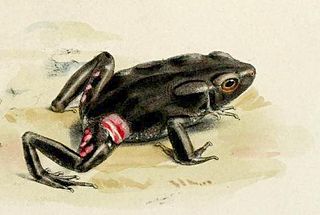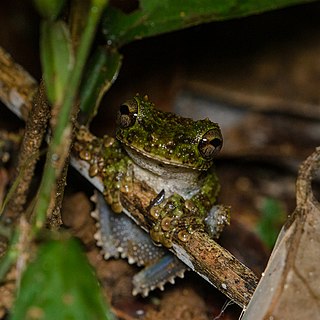
The Carchi Andes toad is a species of toad endemic to the western slopes of the Andes in northern Ecuador and southern Colombia. It is listed as an endangered species due to a restricted range and habitat loss.
Rhinella rostrata, also known as the Mesopotamia beaked toad, is a species of toad endemic to Colombia. It is only known from its type locality near the village of Mesopotamia, on the western slope of the Cordillera Occidental in the south of the Antioquia Department.

Atelopus longirostris is a species of harlequin frog, a member of the family of true toads (Bufonidae). It has been recorded only in northern Ecuador. Records from Colombia probably represent different species. Once listed as extinct by the IUCN, it was rediscovered in 2016 after more than two decade with no sightings.
Atelopus pachydermus is a species of toad in the family Bufonidae. It is found in the Andes of northern Peru and southern Ecuador. Records from Colombia reflect the vagueness of the stated type locality, "Neu-Granada", encompassing territory part of several present-day countries. Other records outside the current range refer to other species. The most recent record of this very rare and possibly extinct species is from around 1995. However, there is a need to reassess the status of this species because of confusion with Atelopus podocarpus.
Rhinella amabilis is a species of toads in the family Bufonidae that is endemic to Ecuador, only occurring in a severely fragmented area less than 100 square kilometres (39 sq mi).
Blomberg's toad, also known as the Colombian giant toad, is a very large species of toad in the family Bufonidae. It is found in rainforests at altitudes between 200 and 650 metres in western Colombia and northwestern Ecuador. It has been recorded in Florida in 1963, apparently because of pet escape or release, but did not get established.

Rhaebo glaberrimus is a species of toad in the family Bufonidae. Its common name is Cundinamarca toad, after its type locality, "Bogota", Cundinamarca, although this location is likely to be incorrectly reported. It is found in eastern Amazonian Colombia, including the lower eastern slopes of the Cordillera Oriental to 1,470 m (4,820 ft) asl, and adjacent Venezuela. Rhaebo ecuadorensis from Ecuador and Peru was formerly confused with this species. It has also been confused with Rhaebo guttatus.

The South American common toad is a species complex of toads in the family Bufonidae. They are found throughout the Amazonian South America and eastern Panama. It was originally believed to be a single species, but is now known to represent a complex of more than one.
Rhinella lindae is a species of toad in the family Bufonidae. It is endemic to Colombia and known from its type locality, Murri in the municipality of Frontino, and from Las Orquídeas National Natural Park, both on the western slope of the Cordillera Occidental, Antioquia Department. The specific name lindae honors Linda Trueb, an American herpetologist. However, common name Murri beaked toad has been coined for this species.
Hyalinobatrachium munozorum, also known as Upper Amazon glass frog, is a species of frog in the family Centrolenidae. It is found in the upper Amazon Basin in Ecuador, Colombia, and northern Bolivia; it is presumably to be found in intervening Peru; earlier records from Peru have been assigned to Hyalinobatrachium carlesvilai.
Hyloxalus breviquartus is a species of frog in the family Dendrobatidae. It is found in the northern part of Cordillera Occidental in Antioquia, Colombia, and in Carchi Province in northwestern Ecuador. Colombian distribution may be wider. Its natural habitats are montane forests next to streams and very humid premontane forests. It is threatened by habitat loss, although it occurs in the Las Orquídeas National Natural Park, its type locality.
Dendropsophus riveroi is a species of frog in the family Hylidae. It is found in the upper Amazon Basin in western Brazil, Bolivia, Peru, Ecuador, and southern Colombia. In Ecuador it has been mixed with the newly described Dendropsophus shiwiarum. The specific name honours Juan A. Rivero.

The Imbabura tree frog is a species of frog in the family Hylidae found in the Pacific lowlands of western Colombia and northwestern Ecuador from the sea level to 1,000 m (3,300 ft) asl.

Osteocephalus buckleyi, also known as Buckley's slender-legged treefrog, is a species of frog in the family Hylidae. It is found along the periphery of the Amazon Basin in Bolivia, Peru, Ecuador, Colombia, northeastern Brazil, Venezuela, Guyana, Suriname, and French Guiana, and also in the Orinoco Delta in Venezuela. It is probably a species complex. Some sources treat Osteocephalus vilmae from Ecuador and Peru as a valid species.

Osteocephalus cabrerai is a species of frog in the family Hylidae. It is found in the Amazon Basin in Brazil (Manaus), northeastern Peru, Ecuador, Colombia, Guyana, and French Guiana, possibly wider. Some earlier records refer to Osteocephalus buckleyi.
Adelophryne adiastola is a species of frog in the family Eleutherodactylidae. It is found in the Amazon Basin in Colombia, Ecuador, Peru, and western Brazil.
Pristimantis ocreatus is a species of frog in the family Craugastoridae. Although often reported as being endemic to the Andes of northern Ecuador, it has also been reported from extreme southern Colombia ; the possibility of range extension to Colombia has been acknowledged. Its type locality is the west slope of volcano Chiles in the Carchi Province, and common name Carchi robber frog has been coined for it. These frogs have pale hands and feet, as if wearing gloves and socks—hence the specific name ocreatus, which is Latin and means "wearing leggings" or "booted".
Pristimantis peruvianus is a species of frog in the family Strabomantidae. It is found in the upper Amazon Basin in western Brazil, southern Ecuador, eastern Peru, and southeast Colombia. Records from Bolivia likely refer to an undescribed species, although it is possible that also the "true" Pristimantis peruvianus is to be found there. Its natural habitats are upland cloud forests, flooded lowland forests, and oxbow palm swamp forests. It is a common species.
Pristimantis subsigillatus is a species of frog in the family Strabomantidae. It is found in the lowlands in south-western Colombia and western Ecuador up to elevations of 1,162 m (3,812 ft) asl. It is sometimes known as Salidero robber frog or engraved rainfrog.
Atelopus pastuso is a species of frog in the family Bufonidae. It has not been seen since 1993, and is possibly extinct.








